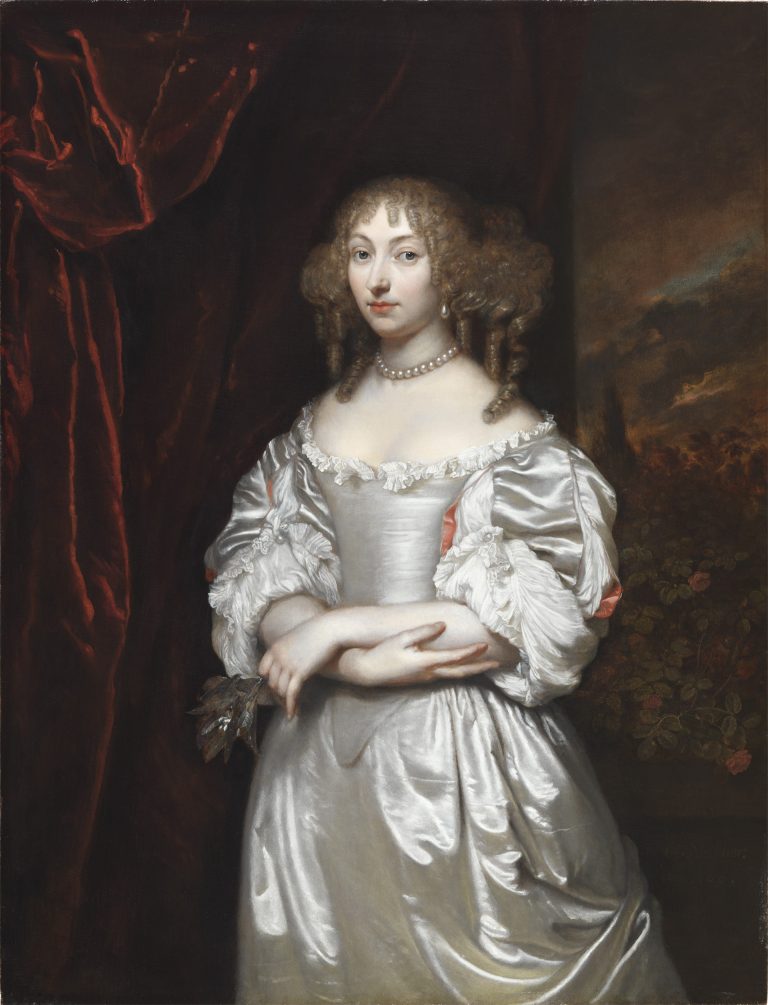Susanna Doublet Huygens (1637–1725) was the youngest of five children (and the only daughter) born to Constantijn Huygens (1596–1687)—renowned poet, connoisseur, and tireless secretary to three Dutch stadholders—and his wife, Suzanna van Baerle (1599–1637). On 20 April 1660 Susanna Huygens married her cousin Philips Doublet III (1633–1707), Heer van Sint Annaland and Mogershill and treasurer general of the United Provinces. Doublet, the son of Constantijn’s sister Geertruyd and Philips Doublet II, is credited with introducing French-style gardens (based on the designs of the French landscape architect André Le Nôtre) to the Netherlands at his estate Clingendael, near The Hague.1 From 1687 Doublet was charged with remodeling the stadholder Willem III’s gardens at Huis ten Bosch also according to French principles. Susanna and Philips Doublet had six children, of whom three lived to adulthood.
From 1667 to 1672, Caspar Netscher painted six portraits of various members of the Huygens family—prestigious commissions from one of the Netherlands’s most respected dynasties.2 The first, a portrait of Philips Doublet, is dated 1667 (fig 1), but may well have been started slightly earlier. A letter from Christiaan Huygens to Doublet, dated 5 November 1666, implies that Huygens had already asked his sister for copies of their portraits by Netscher. A subsequent letter from Huygens to Doublet, dated 26 November 1666, suggests that Doublet had seen to the promised portraits: in it, Huygens cautioned Doublet to pack them well and to make sure they were dry before rolling them and sending them on to Paris. Nearly a year later, in October 1667, Huygens had yet to receive the paintings. He chided Doublet for still leaving them with the painter, commenting “if you expect both of you to become more beautiful than you are before [the painter puts] the last touches to the faces, we will have to wait some time yet.” 3
We do not know when (or if) Huygens ever received the portraits of his sister and brother-in-law: Christiaan’s letter to Susanna Doublet of 20 January 1668 complains “your painting has not yet arrived,” but it is not certain that this refers to either or both paintings by Netscher.4 As the dates on the pendant portraits of Philips and Susanna differ (1667 for the former and 1669 for the latter), it may be that the portrait of Philips was completed first and dispatched to Paris, and the one of Susanna followed later. Huygens’s letters would also seem to suggest that there was more than one autograph version of each portrait—the primary version and the ones sent to Paris—although only one example of each likeness can be traced. Susanna Louisa Huygens (1714–85), the first documented owner of the painting, was the granddaughter (on her maternal side) of Susanna and Philips Doublet and (on her paternal side) of Susanna’s brother Lodewijk Huygens. As the last direct descendant of Constantijn Huygens, she was the heir to several family collections, and it is not recorded from whom she may have inherited Netscher’s portrait of her grandmother and namesake.5
Netscher’s portraits of Susanna and Philips Doublet exemplify the fashionable and highly decorative likenesses that he began to produce in the second half of the 1660s: small, seductive images, projecting an aura of affluence and savoir faire that suited the increasingly cosmopolitan aspirations of a wealthy Dutch patriciate.6 Netscher depicted Susanna in three-quarter length before a lush red velvet curtain and a distant garden view; she is turned slightly to the left, acknowledging the pendant likeness of her husband (fig 1). Susanna wears a white satin gown over a tightly ruched chemise, the sleeves of which are rolled back and pinned up at the elbows with a single pearl. The sleeves of her gown are slashed to reveal a salmon-pink lining, the only touch of color in her otherwise pristine attire. The folds of her skirt are swept back lightly to give the figure an impression of forward movement. Susanna holds a sprig of orange blossoms in her left hand; the flowers were a traditional symbol of purity and thus a suitable attribute for brides and married women.7 When the portrait was cleaned in 2006, overpaint around the sitter’s head was removed to reveal an extravagant coiffure representing the epitome of French-inspired fashion in the years prior to 1670.8 Popularized in France by the Marquise de Sévigné, the style (known as “à la hurluberlu”) featured massive clusters of dangling curls to either side of the head.
In composition and execution the Portrait of Susanna Doublet Huygens can be compared with a number of other female portraits painted by Netscher during the same period in both three-quarter and full length, such as the Portrait of Lady Philippina Staunton, dated 1668 (fig 2), or the Portrait of a Woman, called the Duchess of Cleveland, dated 1669 (fig 3). Particularly successful in the present portrait is the way in which Netscher used the flashes of salmon-colored lining at the sleeves to link the figure with the ruby velvet curtain and the ruddy tones of the background landscape.
